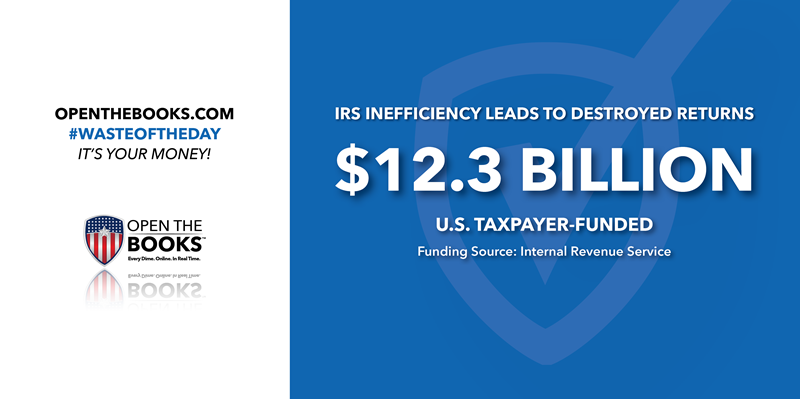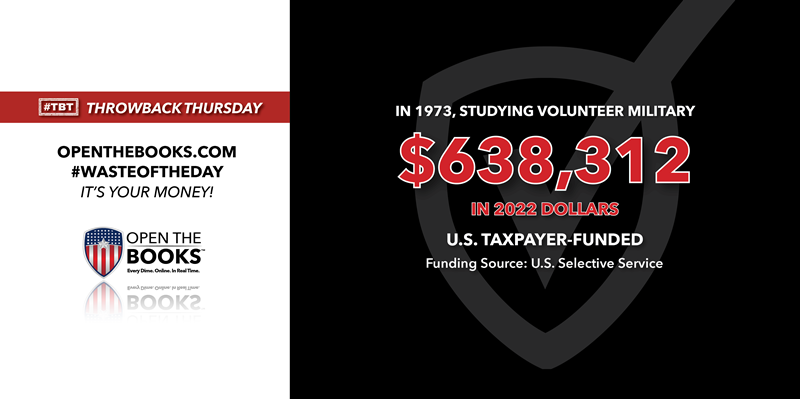
$12.3B Budget Can’t Save IRS From Destroying 30M Paper Returns
June 13, 2022

Despite its $12.3 billion budget, the IRS can’t seem to conduct its most basic function of processing tax returns.
According to a May 2022 report from the Treasury Inspector General for Tax Administration, the IRS destroyed an estimated 30 million tax documents in March 2021.
The agency claims it was unable to process the backlog of paper returns. The destroyed documents were supposed to be used for “post-processing compliance matches” to verify the accuracy of tax returns. Since the IRS can’t process returns after a certain time because the system is taken offline, the 30 million unprocessed documents were simply destroyed.
In 2020, the IRS spent $12.3 billion on overall operations, and employed more than 75,000 full-time employees. Apparently, that wasn’t sufficient to accomplish its main job of processing and verifying tax returns.
Much of this was spent processing paper returns. It costs the IRS $15.21 to process each paper filing of Form 1040, $14.02 for each Form 1041, and $12.98 for partnership filings, like Forms 1065, according to the report.
Conversely, each of those forms only cost around $0.30 to process electronically. The anachronistic practices of still accepting paper returns are costing taxpayers hundreds of thousands of dollars each year.
Americans collectively spend over 6.5 billion hours filing taxes each year, according to the American Action Forum, costing the IRS billions to process.
It is hard to watch all that hard work negated by bureaucratic inefficiency.
New York Sitting on $4.3M Worth of Unused Hand Sanitizer
June 14, 2022

There are about 700,000 gallons of unused hand sanitizer made by prison inmates in New York that went unused and most likely will be destroyed, costing millions of dollars to dispose of it, Politico reported.
In March 2020, then-Gov. Andrew Cuomo announced that New York would begin manufacturing its own supply of hand sanitizer for future distribution. The leftover stockpile is worth about $4.3 million.
At the time, CNN reported that Cuomo said it would cost $6.10 to produce a gallon of the hand sanitizer. With 700,000 gallons left unused, that’s $4.3 million worth of sanitizer that must be destroyed, costing an additional millions of dollars, according to Politico.
Cuomo used prison labor to create the “NYS Clean” hand sanitizer March to October of 2020. Wages started at $0.16 per hour, according to CNN. Cuomo touted the higher alcohol content of NYS Clean, as well as its floral scent.
Now, the 700,000 gallons of hand sanitizer are sitting in warehouses across the state of New York, according to Politico, estimated to cost “millions of dollars to dispose of it, possibly shipped out of state in hundreds of trucks to be incinerated.”
A spokesperson for Cuomo blamed the administration of Gov. Kathy Hochul — Cuomo’s lieutenant governor — for the excessive stockpile, claiming that the Cuomo administration distributed the sanitizer until his resignation in August 2021, Politico reported.
In addition to the unused hand sanitizer, New York state also has 89 new HVAC systems that were never used, that cost, “millions of dollars,” and will be auctioned off this summer, surely for less than their book value, with proceeds given to FEMA, according to Politico.
This is just one of many examples of how the government overreaction to combating Covid that will cost taxpayers for years to come.
Schools Have Spent Only 7% of Covid-19 Funds
June 15, 2022

With the worst of the pandemic over, schools across the country have only spent 7 percent, or about $8.5 billion, of the $122 billion awarded by Congress in the American Rescue Plan Act, according to the Wall Street Journal.
The money was intended to help schools address learning loss, mental health problems, and other pandemic-related issues in K-12 schools. Now, schools are scrambling to spend money, because it must be returned if it’s unspent by September 2024. Schools are using these funds to upgrade facilities, update their technology, hire more teachers and counselors, and expand after-school programs.
The Los Angeles Unified School District, the second largest school district in the nation, has yet to spend any of its $2.6 billion in funding. In fact, it’s still trying to find ways to spend hundreds of millions remaining from earlier Covid-19 relief funds.
Educational organizations are trying to lobby Secretary of Education Miguel Cardona for an extension of the deadline to use the other $113.5 billion worth of funds. Federal officials have said districts can apply for extensions on construction-related projects.
Sen. John Thune, the second highest ranking Republican in the Senate, warned in February 2021 that experts predicted 95 percent of the money given to schools wouldn’t be spent until after 2021, a prediction that turned out to be almost exact.
The use-it-or-lose-it spending spree that will come will lead to enormous amounts of waste of taxpayers money just so the money doesn’t have to be returned to the federal government.
Throwback Thursday: Air Force Base Went on $715K Spending Spree in 1979
June 9, 2022

Throwback Thursday!
In 1979, Clark Air Force Base in The Philippines spent $715,000 — more than $2.8 million in 2022 dollars — on a spending spree to avoid having to give it back.
Sen. William Proxmire, a Democrat from Wisconsin, awarded the Air Force his Golden Fleece Award for their reckless disregard for taxpayers’ dollars.
Leadership at Clark Air Force Base was informed on September 28, 1979, that they had $715,000 left to spend for the fiscal year, and if those funds weren’t spent, they’d have to be returned to the government. Naturally, Air Force leadership conducted the important mission of spending all of that money in only two days.
The remainder of the funds were spent on $333,200 worth of new dormitory furniture, $20,000 for new TVs and fans, $78,700 worth of air conditioning units, $25,900 for new wall and floor coverings, and $32,000 to resurface their tennis courts.
All this money could have been returned to the government to be used for important programs like Social Security, cancer research, or infrastructure.
Instead, they spent taxpayer money on these frivolous and completely unnecessary projects out of fear that Congress would give them less funding the next year.
Use-it-or-lose-it spending like this shows no signs of stopping, either. Open the Books has uncovered over $91 billion of such spending in September 2019.
Indiana Univ. Health Secretly Gives $416M to Med School, Lowering Profit
June 17, 2022

Indiana University Health, the largest healthcare system in Indiana with 16 hospitals statewide, quietly donated $416 million to its associated Indiana University School of Medicine late last year, appearing to lower the healthcare giant’s profits as it faces scrutiny over its $1.1. billion revenue, according to the Associated Press.
There was no public announcement of this donation from either institution, which is unusual for a gift that was larger than all of IU Health’s charitable contributions in the last 11 years combined.
It was only made public by being recorded in the hospital’s December 2021 financial statement.
Some criticized the move as an attempt to reduce the nonprofit healthcare system’s 2021 net profits from over $1 billion to about $860 million as its faces scrutiny from state lawmakers and interest groups.
This is as healthcare costs are crushing the American dream, with the average family paying nearly $20,000 annually between insurance premiums, deductibles, and out-of-pockets costs.
In our 2019 report “Top 82 U.S. Non-Profit Hospitals,” we reported that based on its 990 tax filing in 2017, the “nonprofit” Indiana University Health had $7.8 million in gross assets.
Before 2021, IU Health typically donated around $17 million annually to the IU School of Medicine, with larger gifts around $60 million in 2020 and 2021. Recently, Indiana state lawmakers have scrutinized IU Health for high profits, and wrote a letter in January 2022 calling for lower prices in a state with healthcare prices above the national average.
IU Health defended the gift, claiming that it is a three-year grant, and that there has been a longstanding relationship between the two entities, according to Indiana Daily Student.
Whatever the reason for the donation, public institutions should be transparent about their donations and finances. Public disclosure laws have proven critical to oversight efforts in cases like this, when institutions try to sweep major transactions under the rug.
The #WasteOfTheDay is presented by the forensic auditors at OpenTheBooks.com.